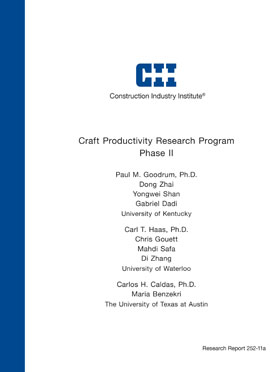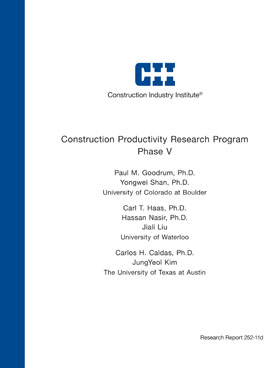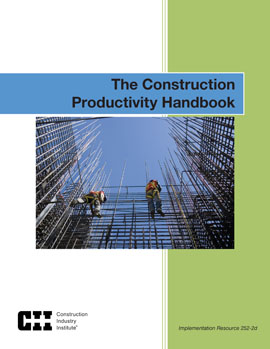
Craft Productivity Research Program -- Phase II
Achieving a 50% improvement in construction craft productivity in six years would break a century-old tradition of stagnation interrupted by periodic improvement. The first phase of a six year research program was successfully completed last year. The following report details the findings from the second phase in this past year.
Direct work typically amounts to no more than 35–45% of a craftsman’s time on the job. To improve craft productivity, direct work time must be improved. To increase direct work time, the availability of materials, information and tools at the workface must be improved. There will be no “magic bullet” that will make this happen, but rather a series of innovations that together produce change. They will include a combination of broad improvements in practice and focused improvements in technology and process.
To achieve these improvements, Research Team 252’s (RT 252’s) rolling, five-phase program injects innovations annually via a sequence of innovation workshops, field trials, analysis, and implementation tool delivery. Each phase of the program involves: (1) analyses of the CII BM&M data to identify best practices that appear to have an impact on productivity, (2) exploring opportunities for productivity improvement through craft information, technology support for labor, work packaging/organization, and human behavior, and (3) soliciting innovation input from structured workshops and team members’ expertise.
Analysis of BM&M data in the second phase was focused on investigating the relationship between particular field practices and productivity of the electrical trades. Significant relationships were found between improved productivity and best practices in automation, integration, materials management, safety, team building, and constructability. These practices, however, are not additive; they are highly correlated and interdependent. Projects that were advanced implementers of these practices experienced as much as a 30% average productivity advantage over projects that were weak implementers. Clearly, implementing these best productivity practices can make all the difference between a weak and a strong performer. But, it is natural to ask whether CII’s BM&M database includes all the best practices or primarily those for which CII has produced products, and whether relatively conventional best practices exist with similar impact.
RT 252’s efforts in the first research phase also focused on a thorough search and definition of best productivity practices. When these practices have become rigorously weighted and properly structured, they will become part of a Best Productivity Practices Implementation Index (BPPII). The BPPII is in the process of being validated in this phase and the next phase, and will be delivered as an implementation tool in the final phase of the program. No existing CII tool addresses productivity as directly as the BPPII will. Until it is fully developed, however, exciting innovations will continue to emerge and this research program will continue to track them.
For this phase of the program, a thorough definition and review of the activity analysis process is outlined. The development of the structure for the process is discussed and validated through an extensive literature review. A step by step review of the process is outlined as well as the required calculations for the development of a final observable output. After the introduction, the team presents the results of the activity analysis for several projects. Recommendations are suggested and then the improvements are quantified after implementation. A final look at the lessons learned is then discussed.
Implementing the best productivity practices identified in this first phase is expected to result in significant productivity improvement on your project. More is yet to come in subsequent project phases. This report includes five chapters. Chapter 1 provides an overview of key management practices relating to the electrical trades. Chapter 2 analyzes project practices and productivity relating to the electrical trades. Chapter 3 takes an in-depth look at the activity analysis process as well as case studies for several projects. Chapter 4 reviews the best productivity practices implementation index (BPPII) and begins validation of the tool with project specific results. Chapter 5 is the conclusions of this report.



